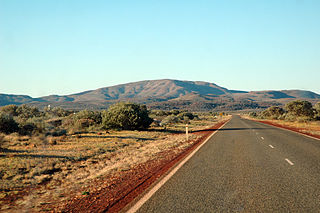
The Hamersley Range is a mountainous region of the Pilbara region of Western Australia. The range was named on 12 June 1861 by explorer Francis Thomas Gregory after Edward Hamersley, a prominent promoter of his exploration expedition to the northwest. Karijini National Park lies within the range.
The Kurrama people, also known as the Puutu Kunti Kurrama people, are an Aboriginal Australian people from the Pilbara region of Western Australia.
The Kartudjara are an Aboriginal Australian people of the Pilbara region of Western Australia.
The Miriwoong people, also written Miriwung and Miriuwung, are an Aboriginal Australian people of the Kimberley region of northern Western Australia.
The Tjuroro, also known as the Jurruru, were an Aboriginal Australian people of the Pilbara region of Western Australia.
The Tharrkari, also referred to as the Targari, are an Aboriginal Australian people of the Gascoyne region of Western Australia.
The Tedei, otherwise known as the Thirrily, are an Aboriginal Australian people of Western Australia. They are a branch of the Yingkarta.
The Jadira are a people and territory in the Pilbara region of Western Australia.
The Nhuwala are an Aboriginal Australian people of the Pilbara region of Western Australia.
The Thalanyji, also spelt Thalandji, Dhalandji, and other variations, are an Aboriginal Australian people in the Pilbara region of Western Australia.
The Ngurlu, also known as the Ngulutjara or Ngurlutjarra, are an Aboriginal Australian people of Western Australia.
The Mandara were an indigenous Australian people of the Pilbara region of Western Australia. They are extinct, having been absorbed into neighboring peoples, and their language is unrecorded.
The Wirdinja were an Aboriginal Australian people of the Pilbara region of Western Australia.
The Unggumi, also written Ongkomi, are an Aboriginal Australian people of the Kimberley region of Western Australian.
The Djiwarli, also written Jiwarli, are an Aboriginal Australian people of the Pilbara region of Western Australia.
The Buruna, also known as the Punduna, are an Aboriginal Australian people of the Mid West region of Western Australia.
The Inawongga were an Aboriginal Australian people of the Pilbara region of Western Australia.
The Ngarlawongga, or more properly Ngarla, were an Aboriginal Australian people of the inland Mid West region of Western Australia. They are not to be confused with the Ngarla who live on the coast.
The Kukatj are an Aboriginal Australian people of the Cape York Peninsula in the state of Queensland. They are to be distinguished from the Kukatja of Western Australia and the Luritja of the Northern Territory, who have also historically been known as Kukatja.
Juukan Gorge is a gorge in the Hamersley Range in the Pilbara region of Western Australia, about 60 kilometres (37 mi) from Tom Price. It was named by the daughter of Puutu Kunti Kurrama man Juukan, also known as Tommy Ashburton, who was born at Jukarinya.